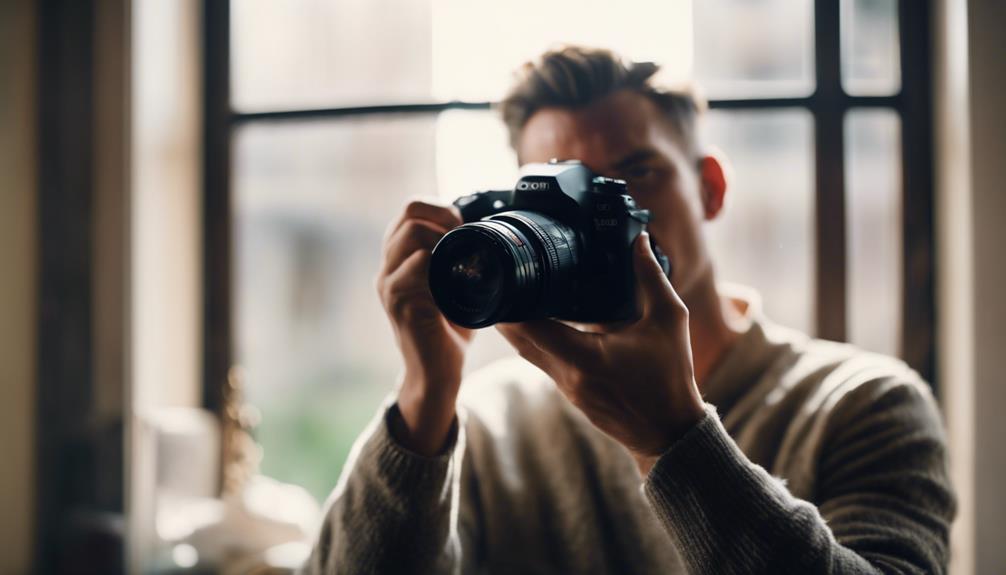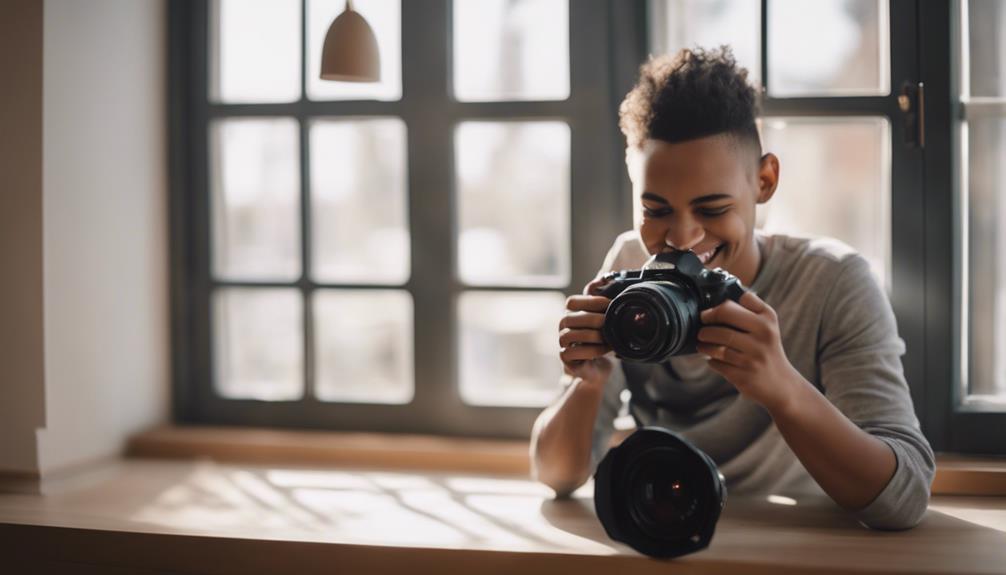To capture professional-looking portraits without breaking the bank, start by utilizing natural light. Overcast days provide a soft, diffused light, perfect for flattering skin tones. Choose a simple, uncluttered background to keep the focus on your subject and apply the Rule of Thirds for a dynamic composition. Encourage your subjects to pose naturally, reflecting genuine expressions. If you're using a smartphone, take advantage of manual controls and experiment with clip-on lenses. Simple, free editing software can drastically enhance your photos post-shoot. With each portrait, you'll refine techniques that bring your artistic vision to the forefront, uncovering more layers in your journey.
Understanding Natural Lighting

Harnessing natural light can significantly enhance the quality of your portraits, blending artistry with authenticity. As you begin to explore the nuanced world of natural lighting, you'll find that the time of day and weather conditions greatly influence the mood and texture of your shots. Bright, sunny days generate harsh shadows and strong contrasts, often challenging but also offering vivid, energetic captures. Conversely, an overcast sky acts as a natural diffuser, softening the light and minimizing shadows for more flattering, gentle portraits.
You'll want to take into account light modifiers, even in outdoor settings. Reflectors are invaluable for directing light to illuminate your subject's face, especially under tricky midday sunlight. A simple white reflector can brighten shadows, while a silver one adds a spark of brightness, essential for bringing life to the eyes. If the sunlight is too intense, using a diffuser can temper its harshness, wrapping your subject in a more forgiving glow.
Mastering these elements isn't just about capturing images; it's about painting with light, using the world as your canvas. Each setting offers unique challenges and opportunities—learning to read and adapt to them will set your portraits apart.
Selecting the Right Background
Selecting the appropriate background is vital, as it can either improve your subject or divert attention from it. You'll want to choose a background that complements your subject without overwhelming it. This is where color theory comes into play. Understanding which colors complement your subject's skin tone, clothing, and mood can transform a simple portrait into a striking composition. For instance, a background with a muted blue can enhance the warmth of your subject's skin tone, creating a harmonious contrast.
Be wary of background clutter, which can sneak into your frame and distract from the focal point. A clean, unobtrusive background ensures that your subject remains the star of the show. If you're shooting outdoors, look for simple textures like a brick wall or a hedge that provides a uniform appearance. Indoors, a plain wall or a curtain with subtle patterns can work wonders.
Always consider the emotional tone you're aiming to convey. A gritty, textured background might suit a raw, emotional portrait, while a serene, soft-hued backdrop could enhance a more tranquil or joyful expression. It's all about context and harmony in your visual storytelling.
Mastering Composition Basics

Exploring the basics of composition is crucial as you frame your subject to capture evocative and balanced portraits. Let's delve into two pivotal concepts: the Rule of Thirds and the Golden Ratio, both of which you'll find invaluable.
The Rule of Thirds involves dividing your frame into nine equal parts with two horizontal and two vertical lines. Position your subject along these lines or at their intersections. This placement naturally draws the viewer's eye into the composition, creating a more dynamic interaction between your subject and their surroundings.
On the other hand, the Golden Ratio, often viewed as a more intricate relative of the Rule of Thirds, features a spiral pattern that directs the viewer's eye through the frame in a natural, flowing manner. You can imagine this as a nautilus shell where your subject is positioned at the smallest division, expanding outward. This approach is especially effective in adding an artistic touch to your portraits, subtly guiding the observer's focus towards your subject through a harmonious and aesthetically pleasing arrangement.
Master these composition techniques, and you'll elevate your portraits from simple snapshots to compelling pieces of art, all without requiring high-end gear. Keep experimenting with these frameworks to see how they can best enhance your photographic vision.
Posing Your Subjects
How do you position your subjects to capture their essence and convey emotion in a portrait? The secret lies in mastering the interplay between facial expressions and clothing choices, ensuring they complement each other to enhance the subject's natural charisma.
| Aspect | Tips |
|---|---|
| Expressions | Encourage natural smiles or thoughtful gazes |
| Posture | Straight, confident shoulders; relaxed arms |
| Hands | Lightly on hips or softly alongside the body |
| Eyes | Direct towards the camera or a natural point |
| Clothing | Match the mood; avoid distracting patterns |
Start by discussing the desired mood with your subject. This conversation can guide their clothing choices, whether it's a formal blazer that screams professionalism or a soft, flowing dress that whispers serenity. Next, work on facial expressions. A genuine smile can soften the entire image, making it feel inviting, while a serious, contemplative look might better suit a dramatic theme.
Encourage your subjects to position their hands naturally, avoiding stiffness. Have them practice different placements, like resting on the lap when seated or lightly touching the face. This helps in creating a relaxed yet structured posture that feels alive.
Utilizing Smartphone Cameras

Your smartphone's camera, with its advanced technology and convenient size, is a powerful tool for creating stunning, professional-looking portraits. You might be surprised how much the quality of pictures can improve with the right techniques and a few smart accessories. Let's explore how you can elevate your smartphone photography game.
First, consider the lighting, which is important for any form of photography but especially for portraits. Natural light is your best friend. Aim for the golden hours—shortly after sunrise or before sunset—when the light is soft and warm. Position your subject such that the light flatters their features.
Next, explore the world of smartphone accessories. A simple clip-on lens can expand the capabilities of your phone's camera, offering wider angles or more detailed close-ups. Additionally, a portable, adjustable tripod can prevent shaky hands and ensure sharper images.
Don't forget to investigate the manual controls available on your smartphone. Many phones now allow you to adjust settings like exposure, focus, and ISO, much like a professional camera. Familiarizing yourself with these settings can dramatically enhance your control over the photographic results. Experiment with these tools to discover which combinations best suit the atmosphere you're aiming to capture in your portraits.
Editing Photos on a Budget
With a variety of free and inexpensive apps available, you can start editing your portraits to professional standards, even on a tight budget. You don't need to break the bank to achieve stunning, gallery-worthy photos. It's all about knowing the right tools and how to use them effectively.
Here are three essential tips to help you master photo editing:
- Choose the Right Free Software: There are numerous free editing software options that provide powerful tools. GIMP and Canva are great choices, offering a wide array of features from basic cropping to advanced color adjustments. They're user-friendly and provide tutorials to help you get started.
- Focus on Color Adjustments: Perfecting the colors in your portraits can transform them from average to extraordinary. Adjust the brightness, contrast, and saturation to enhance mood and skin tones. Most free software includes these essential tools, allowing you to experiment until you find the right balance.
- Learn Basic Retouching: Retouching isn't just for the pros. Tools like clone stamp or healing brush in free software can help you clean up blemishes or unwanted shadows, making your subject look their best without appearing overly processed.
Embrace these techniques and watch your portraits elevate in quality, without spending a dime on expensive editing software.
Learning From Professional Work

Studying the work of established professionals offers invaluable insights into the techniques that elevate portrait photography to an art form. As you explore their portfolios, you'll notice how masterfully they manipulate light and shadow, creating mood and depth in their portraits. Analyzing angles isn't just about how the subject is positioned, but also how these angles interact with the environment, leading your eye through the photo in a dance of focus and narrative.
Critiquing color involves more than appreciating a spectrum of hues; it's about understanding the emotional pull of each shade. Notice how professionals use color to evoke feelings or highlight a particular aspect of the subject. They often choose backgrounds that complement or starkly contrast with the subject, thus making the portrait pop.
Here's a simple breakdown of elements you can study in professional works:
| Element | What to Look For |
|---|---|
| Angles | Interaction between subject and environment, direction of light |
| Color | Harmony or contrast, emotional impact |
| Lighting | Softness, direction, and shadows |
| Composition | Balance, use of space, focal points |
Frequently Asked Questions
What Are the Best Clothing Colors for Portrait Photography?
When selecting clothing colors for portrait photography, consider color psychology and opt for neutral palettes. These shades don't overpower the subject and enhance facial features, creating a timeless look.
Colors like gray, beige, and soft blues blend beautifully with most backgrounds, focusing attention on you rather than your outfit. These choices help evoke a calm, composed atmosphere in your portraits, making them not only striking but also emotionally resonant.
How Important Is Eye Contact in a Portrait?
Ironically, you might think eye contact in a portrait isn't vital—after all, it's just a look.
But, eye contact is essential for creating an emotional connection and enhancing subject engagement.
When your subject looks directly at the camera, it not only captures attention but also speaks volumes, conveying feelings and inviting viewers into the moment.
This powerful tool transforms a simple image into a story, bridging the gap between art and observer.
Can Group Portraits Be as Impactful as Individual Shots?
Absolutely, group portraits can be as impactful as individual shots. When you capture group dynamics and emotional connections among the subjects, you create a powerful narrative. It's about showcasing the relationships and interactions that bring out unique, collective expressions.
Focus on arranging everyone so their emotions and bonds shine through. This not only adds depth to your photo but also tells a compelling story that resonates just as strongly as any solo portrait.
What Are Quick Fixes for Common Skin Issues in Portraits?
Ironically, while you can't Photoshop reality, you can certainly tweak your portraits! Quick fixes for common skin issues start with mastering lighting angles; soft, diffused lighting can minimize blemishes dramatically.
In post-processing, use subtle retouching techniques to enhance the skin without making it look unnatural. Keep it light with adjustments, focusing on maintaining the texture and color balance, which will result in a more refined and artistically pleasing portrait.
How Often Should I Update My Portrait Photography Portfolio?
You should update your portrait photography portfolio every few months to keep it fresh and diverse. Showcasing a variety of styles and subjects reflects your artistic range and adaptability. Additionally, incorporate client feedback to highlight your responsiveness and dedication to customer satisfaction.
This practice not only demonstrates your evolving skill set but also keeps potential clients engaged, showing them you're actively improving and staying current with photographic trends and techniques.
Conclusion
Now, armed with just sunlight and your smartphone, you're poised to capture beauty as vividly as any pro with a high-end camera.
Imagine transforming a simple park bench into the perfect portrait backdrop, or a friend's smile into a timeless masterpiece.
As you edit these snapshots on your budget-friendly apps, remember that each photo isn't just an image, but a story, a piece of art.
So, keep exploring, keep tweaking, and most importantly, keep shooting. Your next great portrait awaits.

